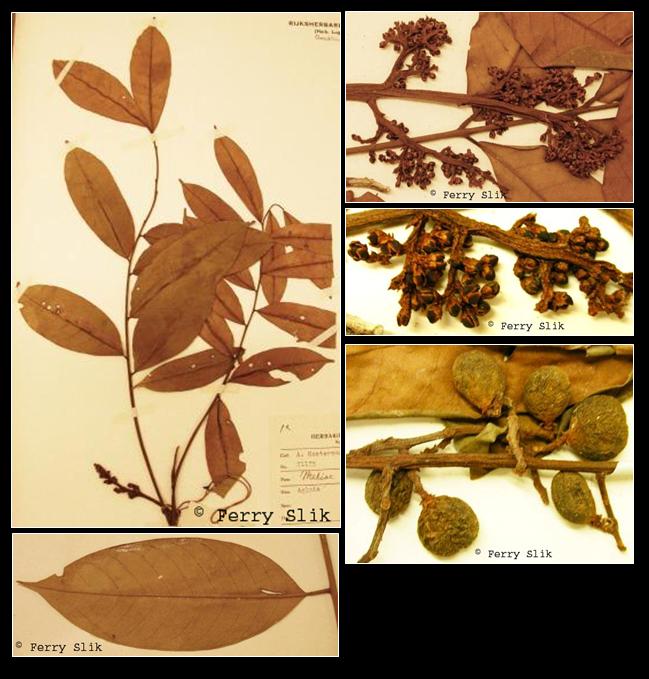Aglaia silvestris (M.Roem.) Merr., Interpr. Rumph. (1917)
Latin for 'growing in the forest'.Synonyms
Aglaia acuminata Merr.
Aglaia baillonii (Pierre) Pierre ex Pellegr.
Aglaia cedreloides Harms
Aglaia cochinchensis Pierre [Invalid]
Aglaia copelandii Elmer
Aglaia forstenii Miq.
Aglaia ganggo Miq.
Aglaia mannii (King ex Brandis) S.S.Jain & R.C.Gaur
Aglaia micropora Merr.
Aglaia multiflora Merr.
Aglaia obliqua C.T.White & Francis
Aglaia pyramidata Hance
Aglaia pyrrholepis Miq.
Amoora ganggo (Miq.) Kurz
Lansium silvestre [Rumph.] M.Roem.
Description
Tree Up to 30 m (-50 m), with a broad rounded crown. Bole up to 13 m, up to 61 cm diameter,
with up to 7 L-shaped buttresses upwards up to 120 cm and outwards
up to 215 cm. Outer bark pale greyish-brown or reddish-brown, longitudinally
split at wide intervals, with longitudinal rows of lenticels; inner bark reddish-brown, or
dark orange-brown; sapwood paler than inner bark; heartwood pale yellowish-brown,
almost white; latex white. Twigs slender, densely covered with peltate scales which
have a dark brown centre and pale margin. Leaves imparipinnate. 19-65 cm long. 14-
35 cm wide; petiole 10-20 cm, petiole, rachis and petiolules densely covered with
scales like those on twigs. Leaflets (5-)13-19, 8-24 by 1.7-6.5 cm, subcoriaceous,
usually oblong, sometimes lanceolate or elliptical, acuminate at apex, rounded or shortly
cuneate at the sometimes asymmetrical base, with scales like those on the twigs densely
covering the upper surface when young but deciduous before maturity and sparse on to
densely covering the lower surface; veins 12-21 on each side of the midrib; petiolules
5-10(-20) mm. Inflorescence up to 30 cm long and 20 cm wide; peduncle up to 15 cm.
peduncle, rachis, branches and pedicels clothed like the twigs. Flowers up to 3.5 mm
long and 2.5 mm wide; pedicel up to 2 mm long, pedicel and calyx densely covered
with scales like those on the twigs. Petals 5 (or 6). Staminal tube longer than the corolla,
obovoid, with a minute pore 0.2-0.3 mm across which is entire at the margin; anthers
5, 1/3 to 1/2 the length of the tube, ovoid, inserted near the base and included in the
lube. Infructescence up to 30 cm long and 25 cm wide, with c. 50 fruits; the peduncle
up to 15 cm. peduncle, rachis. branches and fruilstalks with indumentum like twigs.
Fruits up to 2 cm long and wide, usually obreniform in outline, nallened. wrinkled
when dry. brown, red. orange or yellow, densely covered with scales like those on the
twigs, indehiscent, sometimes subglobose (New Guinea); the fruitstalks up to 1 cm.
Locules 1 or 2 (or 3). each containing 1 seed; aril thin, brown, translucent and sweet.
[from Flora Malesiana]
Ecology
Found in primary forest, swamps, savanna, kerengas, monsoon forest,
moss forest, along roads, along rivers on clayey loam, sandstone, sand, limestone; sealevel
to 2100 m altitude.
Uses
Buttresses for house-building (Solomon Islands: San Cristobal); wood used
for spear shafts (Philippines: Luzon, Mountain Prov.), axe-handles (Solomons: Guadalcanal),
in house construction (Halmahera).
Distribution
Andaman & Nicobar Islands, Thailand, Indo-China to New Guinea.
Local names
Borneo: Bunya, Lapak, Segera.
